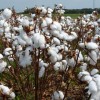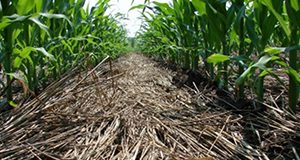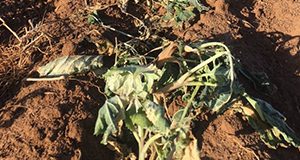When utilizing cover crops for weed suppression, one important consideration is effective termination before planting the main crop. A major issue with improper termination is that the cover crop can become problematic and compete with the main crop, like other weeds. However, proper planning of the termination timing and method can minimize these issues and maximize the benefits of cover crop use. This 5-page publication discusses herbicide application, roller-crimper termination, tillage, and appropriate growth stages for termination. Written by Pratap Devkota, Michael J. Mulvaney, and David Wright, and published by the UF/IFAS Agronomy Department, February 2021.
https://edis.ifas.ufl.edu/ag449
Tag: David Wright
Overseeding Rhizoma Perennial Peanut Pasture and Hay Fields during the Cool Season
Hay and livestock producers want to know if they can overseed their rhizoma peanut fields with cool-season forages during rhizoma perennial peanut dormancy. This new 5-page document discusses overseeding for hay and overseeding for grazing. Written by Jose Dubeux, Cheryl Mackowiak, Ann Blount, David Wright, and Luana Dantas, and published by the UF/IFAS Agronomy Department, January 2019.
http://edis.ifas.ufl.edu/ag426
Frost Damage of Carinata Grown in the Southeastern US
Brassica carinata is an annual oilseed crop used for the commercial production of jet fuel. One of the challenges to commercialization of this crop in the southeastern United States has been frost damage. This 4-page fact sheet discusses symptomology and ways to minimize risk of frost damage to carinata. Written by Michael J. Mulvaney, Ramdeo Seepaul, Ian Small, David Wright, Silvana Paula-Moraes, Carl Crozier, Paul Cockson, Brian Whipker, and Ramon Leon, and published by the UF/IFAS Agronomy Department, May 2018.
http://edis.ifas.ufl.edu/ag420
2013 Cotton Defoliation and Harvest Aid Guide
 In Florida, cotton requires about 155 days of growth from planting to harvest. Throughout the growing season, growers must make important management decisions about defoliation, boll opening, and regrowth suppression. These factors can affect the quality and storage time if the crop is put into modules. The greatest losses in quality are caused by stain from poorly defoliated plants or regrowth and moisture from green tissue. This 8-page fact sheet was written by R.G. Leon, D. L. Wright and B. J. Brecke, and published by the UF Department of Agronomy, October 2013.
In Florida, cotton requires about 155 days of growth from planting to harvest. Throughout the growing season, growers must make important management decisions about defoliation, boll opening, and regrowth suppression. These factors can affect the quality and storage time if the crop is put into modules. The greatest losses in quality are caused by stain from poorly defoliated plants or regrowth and moisture from green tissue. This 8-page fact sheet was written by R.G. Leon, D. L. Wright and B. J. Brecke, and published by the UF Department of Agronomy, October 2013.
http://edis.ifas.ufl.edu/ag188
Agricultural Management Options for Climate Variability and Change: Sod-Based Rotation (AE492)
 A sod-based rotation is when a producer adapts a conventional peanut/cotton rotation by growing a perennial grass, such as bahiagrass, during two years of the rotation. The perennial grass can be grazed, cut for hay or harvested for seed for additional income. Using a sod-based rotation can improve soil water-holding capacity and potentially reduce impacts of dry spells and droughts. This 4-page fact sheet was written by David Wright, Jim Marois, Clyde Fraisse, and Daniel Dourte, and published by the UF Department of Agricultural and Biological Engineering, August 2012. http://edis.ifas.ufl.edu/ae492
A sod-based rotation is when a producer adapts a conventional peanut/cotton rotation by growing a perennial grass, such as bahiagrass, during two years of the rotation. The perennial grass can be grazed, cut for hay or harvested for seed for additional income. Using a sod-based rotation can improve soil water-holding capacity and potentially reduce impacts of dry spells and droughts. This 4-page fact sheet was written by David Wright, Jim Marois, Clyde Fraisse, and Daniel Dourte, and published by the UF Department of Agricultural and Biological Engineering, August 2012. http://edis.ifas.ufl.edu/ae492
Production of Biofuel Crops in Florida: Sweet Sorghum (SSAGR293/AG298)
 Varieties of sorghum with a high concentration of soluble sugars are attractive as a potential energy crop because of the easy accessibility of readily fermentable sugars combined with very high yields of green biomass. Similar to sugarcane, the sap of sweet sorghum is extracted by milling, and can be easily fermented to produce ethanol. Other products from sweet sorghum include syrup, molasses, and crystal sugar. This 3-page fact sheet was written by Wilfred Vermerris, John Erickson, David Wright, Yoana Newman, and Curtis Rainbolt, and published by the UF Department of Agronomy, December 2011.
Varieties of sorghum with a high concentration of soluble sugars are attractive as a potential energy crop because of the easy accessibility of readily fermentable sugars combined with very high yields of green biomass. Similar to sugarcane, the sap of sweet sorghum is extracted by milling, and can be easily fermented to produce ethanol. Other products from sweet sorghum include syrup, molasses, and crystal sugar. This 3-page fact sheet was written by Wilfred Vermerris, John Erickson, David Wright, Yoana Newman, and Curtis Rainbolt, and published by the UF Department of Agronomy, December 2011.
http://edis.ifas.ufl.edu/ag298
Farmer Perceptions of Wildlife Damage to Row Crops in North Florida (WEC311/UW356)
 How can we determine the just how much of an impact wildlife damage has on growers? This 4-page fact sheet presents the results of a survey of a sample of growers across the state. Written by Holly K. Ober, Gerald R. Edmondson, William M. Giuliano, David L. Wright, John Atkins, Andy Andreasen, Shep Eubanks, Libbie Johnson, Charles Brasher, and Greg Hicks, and published by the UF Department of Wildlife Ecology and Conservation, July 2011.
How can we determine the just how much of an impact wildlife damage has on growers? This 4-page fact sheet presents the results of a survey of a sample of growers across the state. Written by Holly K. Ober, Gerald R. Edmondson, William M. Giuliano, David L. Wright, John Atkins, Andy Andreasen, Shep Eubanks, Libbie Johnson, Charles Brasher, and Greg Hicks, and published by the UF Department of Wildlife Ecology and Conservation, July 2011.
http://edis.ifas.ufl.edu/uw356
Camelina Production in Florida (SSAGR340/AG350)
Camelina (Camelina sativa (L)) is an old-world crop used primarily for oil. It can be grown under semi-arid conditions. Breeding efforts have resulted in very few improvements. It is a member of the Brassicaceae or mustard family and related to canola and cole crops. The seed is about 35% oil, and the oil is high in omega-3 fatty acid, which has been cited as having health benefits. Camelina meal can be fed to livestock, producing eggs and meat that are higher in omega-3 fatty acids. Interest in camelina is not only due to its high level of omega-3 fatty acids but because it is a renewable source of feedstock for biodiesel and advanced biofuels.
This 3-page fact sheet was written by David Wright and Jim Marois, and published by the UF Department of Agronomy, February 2011.
http://edis.ifas.ufl.edu/ag350


